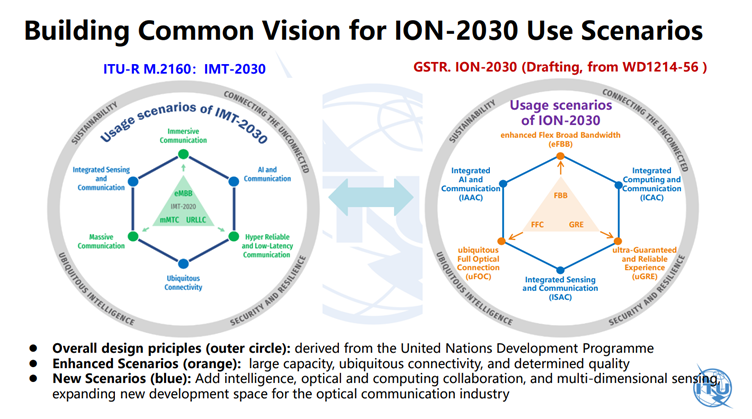
What is the ITU and what does ITU-T SG15 do?
ITU-T SG15 is the primary standards bodies for optical networking including access systems, core systems, and submarine systems, as well as all the necessary optical components including optical fibre. In addition, it sets standards for timing and synchronisation which are closely related. I set out a much more detailed introduction to the ITU-T and its Study Group 15 in our blog post from its previous plenary meeting.
Hot Topics at this Paris Meeting
This meeting in Paris was really two meetings in one. Thursday afternoon was set aside for the third and final SG15 Workshop on the five to ten year vision for optical systems under the title of “International Optical Network towards 2030 and beyond” (ION-2030). This consciously mirrors the ITU-R work on “International Mobile Telecoms towards 2030 and beyond” (IMT-2030), which now forms the basis for 6G mobile in 3GPP and other related bodies.
Most of the week was devoted to an interim meeting to progress work on specific work items of SG15, in particular: Q6 – optical components, Q12 – architecture, Q13 – timing and synchronisation, and Q14 – management. (Q2 – access systems, and Q11 – interfaces and optical networking also had interim meeting, however they were not co-located).
Interim meetings like this tend to focus on specific work items in parallel and do not normally come together to collectively review the work. That process is reserved for ‘plenary’ meetings, the next of which will be in Geneva this November. In Paris, as well as attending the workshop, I participated in the work of Q12 and Q14.
When the last plenary meeting in Geneva agreed to work on ION-2030, Q12 was given the coordination role and responsibility for producing the resulting technical report. As a result, much of Q12’s time in Paris was devoted to drafting this technical report.
The other topic of particular note was the joint work between Q12 and Q14 on the functional modelling and management information modelling of physical media networks and the transparent optical networking they support.
In this blog, I have taken the workshop as a framework, as it was - by design and intent - already identifying and summarising the hot topics of SG15. I’ve added some comments on the work Q12 and Q14 on management interfaces for the latest optical systems, which is directly relevant to the interfaces needed for AI systems to automate network configuration and control.
ION-2030 Workshop
“Future Optical Networks for IMT-2030, AI, Broadband and More”
Approach of China to Vision and Innovation
While most of the world is developing new optical technologies and new network architectures which can exploit them, there are differences in the way different regions are approaching the coordination of this innovation. China, and to a lesser extent Japan and South Korea, are following nationally coordinated programmes which place significant emphasis on a strong vision for this industry and an expectation that their national industry will all follow and collaborate in fulfilling this vision.
This workshop had active participation from across the world, however, it is fair to say that China is particularly concerned with setting a vision which will drive the industry. As such the content is helpful from two different perspectives. First, the vision presented is helpful in making judgements as to what the future optical world will look like as it reflects the collected views of many knowledgeable people and organisations. Second, it gives insight into the agenda that China especially is likely to pursue and, given the size and growth in the Chinese market, this will inevitably impact the global industry.
The following are some highlights from the workshop. A video of all the presentations and pdfs of the slides are available from the ITU-T SG15 website[1].
Drives for Optical Networking towards 2030 and beyond
What is driving the demand for new optical networking technology and why? This is a key starting question and there was little disagreement on the broad answer. It was significant that the summary presentation on this question did not start with any of the three drives in the title of the workshop, but with data centre networking. Indeed, the presenter stated it was deliberately and unapologetically put first.
- Data Centre Networking: Data centres are driving enormous volumes and growth in optical networking requirements both within the data centre (intra DC networking) and between data centres (inter DC networking). Much of this is underpinned by the recent advances in AI large language models, which are in turn driving massively parallel GPU architectures. These volumes are giving rise to the mass scale, low-cost optical solutions which are available for exploitation in general networking.
- IMT-2030/6G: Many of the proposals for 6G require advances in optical technologies, especially in the radio access network (RAN). As well as higher bandwidths, these also include support for multiple signals required for MIMO, especially distributed MIMO and cell-free architectures, and some very exacting timing and synchronisation requirements (see more detail below).
- AI: AI has the potential to automate and improve efficiency in many aspects of life. The impact of AI on networks, including 6G and optical networking, is broadly split into two halves. First, the use of AI within the network to support automation and efficiency of the network. Second, the need for the network to support the significant bandwidth needed by AI systems used in other industries.
- Broadband: The main emphasis is on extending fibre reach to within building (fibre to the room – FTTR) and increasing bandwidths on access PON systems. While 10G is now the current standard solution, 50G PON standardisation is well advanced and preliminary work is underway of very high speed PON (VHSP) with an expected rate of 200G.
AI and optical networking
Despite much discussion in the press and beyond on the ethical implications of AI and large language models, for SG15 there are a full range of issues which need to be addressed under “responsible AI”, notably:
- Data security, isolation, and inviolability.
- Energy consumption.
- Survivability, or resilience to catastrophic events.
- Network resources consumption
The conclusion was that addressing AI requirements and these issues was driving a much more distributed AI architecture than we currently see and for which the network was not yet ready.
Specifically, it seems likely this will create the need to support multi-layer optical networking, i.e. a) fibre spatial switching, b) optical band switching (i.e. transparent to number of wavelengths and their modulation), and c) optical channel switching[2].
Timing and Synchronisation
Very accurate timing and synchronisation, as specified by Q13 in SG15, is finding its way into datacentres, underlining the general convergence in technologies between datacentres and the general network. A specific example of the value of accurate timing to the scheduling and control of traffic in lock-free distributed databases was cited, where uncertainty in delay is a critical parameter. This requirement was driving new requirements for timing and synchronisation in Q13 and IEEE1588, allowing for both highly accurate measurement of time and traffic control mechanisms supporting the lock-free distributed databased.
From a more familiar network perspective, timing and synchronisation requirements continue to develop for mobile RAN in 6G and beyond. Two particularly interesting and important conclusions were: first, the timing requirements for many potential 6G radio features are 2-3 orders of magnitude more exacting than the current requirement of 1.5μs, however, second, the requirements were for a relative accuracy between adjacent masts, rather than an absolute accuracy to UTC. This observation opens up a different direction for timing and synchronisation specification and the possibility of effective solutions within the scope of current and easily foreseeable technology.
Broadband
Fixed broadband access is largely focussed on increasing access bandwidth, especially to consumers and small business sites using passive optical networks (PONs). Q2 is developing its specification for the next generation of PON, very high speed PON (VHSP). The key issue is always cost, especially on the consumer end, and the ability to reuse existing fibre infrastructure. The main technical debate is whether the existing low-cost modulation strategy of intensity modulation with direct detection (IM-DD) can be stretched to the requirements of VHSP - which includes using existing fibre deployed to existing standardised loss budgets - or whether PON systems need to move to the more expensive coherent optical technology.
There is no immediate conclusion to this debate, only observing that IM-DD would likely be low cost, however, coherent would be technologically secure. Even within coherent, there were potential options, and time was needed to see which might be cost effective. Q2 is developing a detailed classification of candidate technologies for further evaluation.
How much capacity is needed?
Both in access and in core, the optical technologies are at critical ‘inflection points’. With access, the issue is whether the next generation equipment needs to switch to coherent technology. In core, the issue is whether there is a need to invest in more fibre.
In both cases, as the investment, development, and exploitation take many years, estimating the long-term growth in traffic is very important. However, there is a lot of uncertainty in those forecasts. Historic growth rate in network capacity has been around 50% year on year growth, and a plausible assumption is that these historic growth rates will continue. However, these growth rates have been largely driven by video content and there is a countering view that total volumes are now plateauing. A large group from European industry suggested a more conservative figure of 25% year on year growth.
When taken over 10 years, the difference between these two growth assumptions is a factor of six. This difference of nearly an order of magnitude in the forecast assumptions drives quite different technology assumptions, affecting the assumptions on when VHSP will be needed and when, and if, a new wave of core fibre investment is needed. The basic message from the European group was that there is more time to develop the technologies and make any decision on augmenting fibre infrastructure.
Importance of creating a visual message
An interesting observation from the development of the ION-2030 draft was the desire from organisations, notably Chinese, to explicitly reference the IMT-2030 ‘wheel diagram’[3] and create a matching equivalent for optical networking.
What was clear from the discussion was that the labelling needed to match the shape of the diagram, not the other way around. Those proposing the diagram were completely open to suggestions and counter proposals on how the six points of the hexagon were labelled. However, they were immovable on the stance that it needed to be a hexagon with six points exactly mirroring IMT-2030. In other words, the ‘red line’ of proposal was the visual form, not the detailed content.
The key points seemed to be:
- The vision for optical networking is aligned with the vision for mobile
- Like mobile, the scope of application areas from optical networking is growing
It’s about the branding and the visual message – and possibly there is a lesson that not too much should be read into the detail of the diagram!

Question 12/14
During the week in Paris, much of the time in Q12 (architecture) was taken up with the drafting of the ION-2030 technical report. The other main topic was a joint session with Q14 (management interfaces) developing the management interface for transparent optical networking.
Functional architecture and management information of model for optical networking
The architectural methodology standardised by SG15 and the management interfaces developed using this methodology have been managing the world transport[1] networks for many years.
Up until now, all the basic pipes being managed can be defined in ‘bits’, for example as a fixed rate bit stream, or as a stream of data packets. However, with transparent optical networking, the basic pipes are analogue, not digital, and are defined by optical frequency, modulation bandwidth, signal to noise ratio, non-linear effects, etc.
The challenge which Q12 and Q14 are addressing is how to exploit the existing, well established and successful management systems to manage this different world of analogue pipes.
Why Get Involved?
Much of the work elsewhere in ITU-T is concerned with non-technical matters, and detailed technical work is primarily done in other standards bodies like 3GPP, IETF, and IEEE. The notable exception is optical networking (both access and core networking as well as timing and synchronisation) where ITU-T SG15 remains the primary technical body.
There is lots of exciting innovation in optical components, but components need to be integrated into networks to be useful, and this is where SG15 matters. So even if your interest is a specific optical component technology, it’s important it integrates easily. And that means SG15 standards.
Also, comparatively speaking, SG15 is reasonably accessible for new participants, especially if you make linkage with participants from the same country, in our case the UK. If your field is optics, do get in touch.
[1] ITU Workshop on “Future Optical Networks for IMT2030, AI, broadband and more"
[2] Further details can be found in Horizon projects PROTEUS-6G and FLEX-SCALE
[3] ITU-R Recommendation M.2160
[4] For clarification ‘transport’ here means bulk capacity management sometimes and should ne be confused with ‘transport’ as used by IETF for ‘layer 4’ protocols like TCP, UDP, QUIC, etc.









